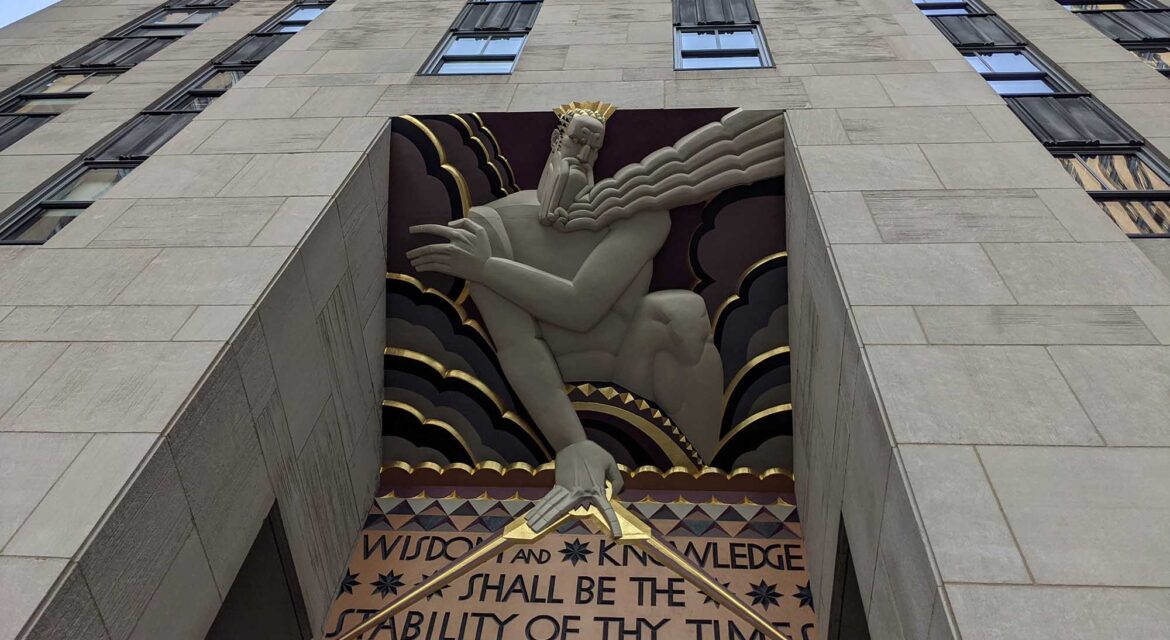 The artwork at Rockefeller Center has set the standard for public art in New York City. Audiences from across the city and beyond come to experience the art deco murals, reliefs, sculptures, carving and more. Doing so has created opportunities for engagement that allow audiences to explore and appreciate the beauty of the space and city on multiple levels.
The artwork at Rockefeller Center has set the standard for public art in New York City. Audiences from across the city and beyond come to experience the art deco murals, reliefs, sculptures, carving and more. Doing so has created opportunities for engagement that allow audiences to explore and appreciate the beauty of the space and city on multiple levels.

A Vision for New York City
 The 1930s construction of Rockefeller Center was driven by John D. Rockefeller Jr, whose vision was for Rockefeller Center was to create a “city within a city.” It was envisioned as a place where New Yorkers could surround themselves with art and motifs that celebrated the best of the human spirit. Starting in 1932, numerous artists were commissioned to complete murals, mosaics, and sculptures. While the Art Deco style that defines these pieces wasn’t his original vision, this approach would end up influencing these pieces as well as the architecture of Rockefeller Center itself.
The 1930s construction of Rockefeller Center was driven by John D. Rockefeller Jr, whose vision was for Rockefeller Center was to create a “city within a city.” It was envisioned as a place where New Yorkers could surround themselves with art and motifs that celebrated the best of the human spirit. Starting in 1932, numerous artists were commissioned to complete murals, mosaics, and sculptures. While the Art Deco style that defines these pieces wasn’t his original vision, this approach would end up influencing these pieces as well as the architecture of Rockefeller Center itself.
The Art Deco murals, mosaics, and sculptures are located in various places and take many forms across Rockefeller Center, enabling audiences to experience them in various ways. The most prominent expression of this style can be seen in pieces like Atlas as well as Wisdom, which has become an icon that resides over the entrance to the main building of Rockefeller Center and can be seen from Fifth Avenue. Smaller and somewhat hidden pieces can be seen at every level though.
News, which resides over the main entrance to 50 Rockefeller Plaza, was the largest metal bas-relief in the world at the time of its completion. The Intelligence of Man Awakening is made up of over one million small glass tiles in over 250 colors, while Prometheus is said to be the best-known sculpture in Rockefeller Center and the most photographed monumental sculpture in all of NYC. Art prints of these pieces are readily available.
These are just a few of the numerous Art Deco and art pieces that define the space but the many different events and activities create further experiences at Rockefeller Center. The most prominent of them is the Rockefeller Center Christmas Tree and Skating Rink, but various events take place across the space throughout the year. Additionally, the Top of the Rock observation deck provides audiences with a 360-degree view of New York City.
The Art Deco style that defines Rockefeller Center helped it to become recognized as a National Historic Landmark in 1987, highlighting what it can mean to enable such distinct experiences across an entire landmark.

Enabling Experiences
 The Art Deco style impacts each of the 19 buildings that make up Rockefeller Center, highlighting what it can mean to enable distinct experiences across an entire complex. Doing so transformed what might otherwise be another complex or plaza just like any other in New York City into a space that is featured on maps and guides to the city, capturing the attention of audiences from across the city and beyond.
The Art Deco style impacts each of the 19 buildings that make up Rockefeller Center, highlighting what it can mean to enable distinct experiences across an entire complex. Doing so transformed what might otherwise be another complex or plaza just like any other in New York City into a space that is featured on maps and guides to the city, capturing the attention of audiences from across the city and beyond.

